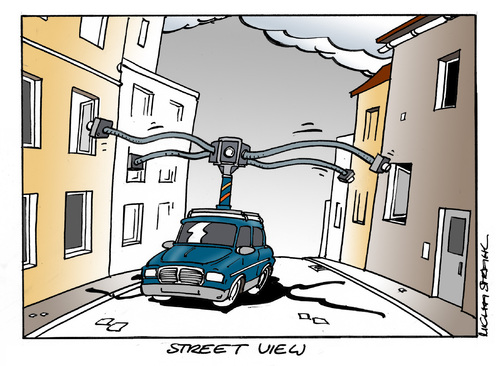“Your worst enemy, he reflected, was your nervous system. At any moment the tension inside you was liable to translate itself into some visible symptom.”
– George Orwell, 1984

(Illustration found here).
The US Department of Homeland Security (a near-perfect Orwellian title) via its Transportation Security Administration (TSA) in a $3.5 million study is seeking to eyeball your eyeball.
From Forbes on Wednesday:
One project allocated to Northeastern University and Siemens would mount backscatter x-ray scanners and video cameras on roving vans, along with other cameras on buildings and utility poles, to monitor groups of pedestrians, assess what they carried, and even track their eye movements.
In another program, the researchers were asked to develop a system of long range x-ray scanning to determine what metal objects an individual might have on his or her body at distances up to thirty feet.
“This would allow them to take these technologies out of the airport and into other contexts like public streets, special events and ground transit,†says Ginger McCall, an attorney with EPIC.
“It’s a clear violation of the fourth amendment that’s very invasive, not necessarily effective, and poses all the same radiation risks as the airport scans.â€
The documents were obtained by a Freedom of Information Act request from the non-profit Electronic Privacy Information Center (EPIC) and although the TSA denies the whole thing — “TSA has not tested the advanced imaging technology that is currently used at airports in mass transit environments and does not have plans to do so,†an official said — one can assume the entire operation is either already online or waiting word to be executed.
Even with what government agents claim are “safeguards” against illegal use, like privacy enhancements and nondescript images.
But EPIC’s McCall says that those safeguards are irrelevant: If scanners are deployed in public settings, it doesn’t matter if they show full naked images or merely the objects in a user’s pockets.
“When you’re out walking on the street, it’s not acceptable for an officer to come up and search your bag without probable cause or consent.,†she says.
“This is the digital equivalent.â€
And no mater what:
In August of last year, Joe Reiss, the vice president of marketing of security contractor American Sciences & Engineering told me in an interview that the company had sold more than 500 of its backscatter x-ray vans to governments around the world, including some deployed in the U.S.
Those vans are capable of scanning people, the inside of cars and even the internals of some buildings while rolling down public streets.
The company claims that its systems’ “primary purpose is to image vehicles and their contents,†and that “the system cannot be used to identify an individual, or the race, sex or age of the person.â€
But Reiss admitted that the van scans do penetrate clothing, and EPIC president Marc Rotenberg called them “one of the most intrusive technologies conceivable.â€
And this can happen to anyone considered by the US government as “suspicious” — not just people with an Islamic appearance or name, that’s just today’s governmental reasoning.
An Egyptian American student studying business at Mission College in California, and who has no criminal record or “suspicious” behavior, is suing the FBI because they placed a secret GPS tracking device on his car.
The chilling, scary part: Although placing a tracking device on someone’s car without court approval or a citizen’s awareness would seem like a violation of privacy, many U.S. courts have OK-ed the tactic as a legitimate form of surveillance.
What year is this?